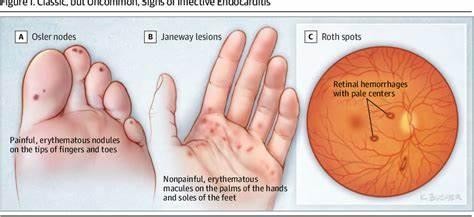An adolescent boy is admitted with the following symptoms: Slow onset of recurrent low-grade fever, fatigue, weakness, joint and muscle aches, loss of appetite, weight loss and diaphoresis.
On assessment the nurse auscultates a new heart murmur, splenomegaly, petechiae, splinter hemorrhages under the nails and Osler nodes (red, painful non-hemorrhagic nodules on the pads of fingers and toes.
Which of the following Acquired Heart Diseases does this best represent?
Infective endocarditis
Tetralogy of Fallot
Acute rheumatic fever
Pulmonary hypertension
The Correct Answer is A
A. The symptoms described, including slow onset of recurrent low-grade fever, fatigue, weakness, joint and muscle aches, loss of appetite, weight loss, and diaphoresis, along with the presence of a new heart murmur, splenomegaly, petechiae, splinter hemorrhages under the nails, and Osler nodes, are classic signs and symptoms of infective endocarditis (IE).

B. Tetralogy of Fallot is a congenital heart defect characterized by four specific abnormalities in the heart's structure. The symptoms described do not align with the characteristic features of Tetralogy of Fallot.
C. Acute rheumatic fever is an inflammatory condition that can develop as a complication of untreated streptococcal infections, particularly strep throat. While it can lead to heart valve damage (rheumatic heart disease), the symptoms described are more indicative of infective endocarditis rather than acute rheumatic fever.
D. Pulmonary hypertension is a condition characterized by elevated blood pressure in the pulmonary arteries. While it can present with symptoms such as fatigue and weakness, it typically does not manifest with the constellation of symptoms described, including fever, joint and muscle aches, and the presence of Osler nodes and splinter hemorrhages.
Nursing Test Bank
Naxlex Comprehensive Predictor Exams
Related Questions
Correct Answer is D
Explanation
A child with nephrotic syndrome is not infectious and therefore, does not pose a significant risk of infection to the child
A child recovering from a ruptured appendix may still carry an infection posing a risk of life threatening infection to the child with leukemia.
Although rheumatic fever occurs several days after the active streptococcal infection starts, a child with rheumatic fever still poses a risk of infection to the child with leukemia.
Correct Answer is C
Explanation
A. While assessing for pain is important, it is not the priority in this situation. The presence of pink- colored urine and a palpable mass in the abdominal area are more concerning findings that warrant immediate investigation.
B. Obtaining a urine specimen for analysis is important for diagnosing the cause of the hematuria (blood in the urine), which is a common symptom of Wilms tumor. However, this is not the immediate priority compared to preventing potential harm to the child by avoiding pressure on the abdominal area.
C. Instructing the parent to avoid pressing on the abdominal area is the priority action. Wilms tumor can rupture with pressure, which can lead to the spread of cancer cells. It is crucial to minimize handling of the tumor to prevent tumor spillage into the abdominal cavity.
D. The decision to schedule additional diagnostic tests, such as an abdominal ultrasound, can be made based on the results of the urinalysis and further clinical assessment.
Whether you are a student looking to ace your exams or a practicing nurse seeking to enhance your expertise , our nursing education contents will empower you with the confidence and competence to make a difference in the lives of patients and become a respected leader in the healthcare field.
Visit Naxlex, invest in your future and unlock endless possibilities with our unparalleled nursing education contents today
Report Wrong Answer on the Current Question
Do you disagree with the answer? If yes, what is your expected answer? Explain.
Kindly be descriptive with the issue you are facing.
